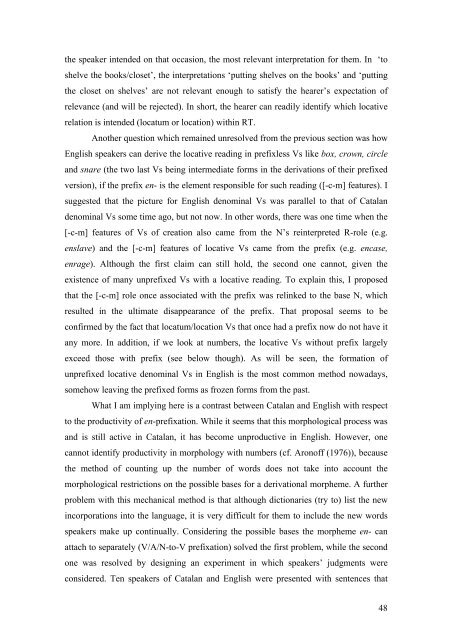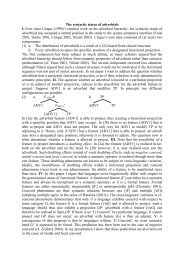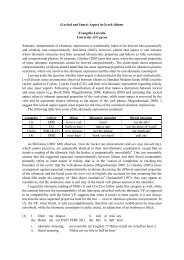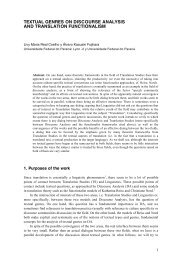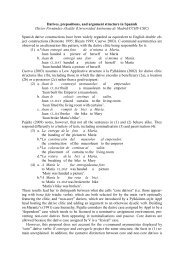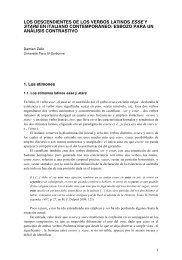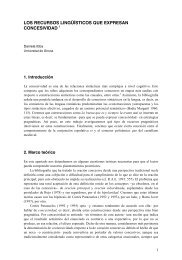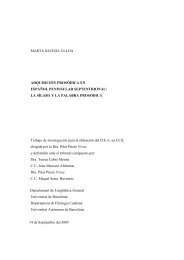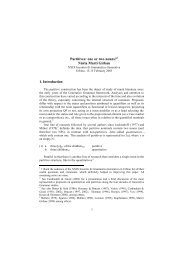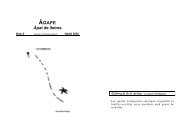Prefixation in English and Catalan - Departament de Filologia ...
Prefixation in English and Catalan - Departament de Filologia ...
Prefixation in English and Catalan - Departament de Filologia ...
Create successful ePaper yourself
Turn your PDF publications into a flip-book with our unique Google optimized e-Paper software.
the speaker <strong>in</strong>ten<strong>de</strong>d on that occasion, the most relevant <strong>in</strong>terpretation for them. In ‘to<br />
shelve the books/closet’, the <strong>in</strong>terpretations ‘putt<strong>in</strong>g shelves on the books’ <strong>and</strong> ‘putt<strong>in</strong>g<br />
the closet on shelves’ are not relevant enough to satisfy the hearer’s expectation of<br />
relevance (<strong>and</strong> will be rejected). In short, the hearer can readily i<strong>de</strong>ntify which locative<br />
relation is <strong>in</strong>ten<strong>de</strong>d (locatum or location) with<strong>in</strong> RT.<br />
Another question which rema<strong>in</strong>ed unresolved from the previous section was how<br />
<strong>English</strong> speakers can <strong>de</strong>rive the locative read<strong>in</strong>g <strong>in</strong> prefixless Vs like box, crown, circle<br />
<strong>and</strong> snare (the two last Vs be<strong>in</strong>g <strong>in</strong>termediate forms <strong>in</strong> the <strong>de</strong>rivations of their prefixed<br />
version), if the prefix en- is the element responsible for such read<strong>in</strong>g ([-c-m] features). I<br />
suggested that the picture for <strong>English</strong> <strong>de</strong>nom<strong>in</strong>al Vs was parallel to that of <strong>Catalan</strong><br />
<strong>de</strong>nom<strong>in</strong>al Vs some time ago, but not now. In other words, there was one time when the<br />
[-c-m] features of Vs of creation also came from the N’s re<strong>in</strong>terpreted R-role (e.g.<br />
enslave) <strong>and</strong> the [-c-m] features of locative Vs came from the prefix (e.g. encase,<br />
enrage). Although the first claim can still hold, the second one cannot, given the<br />
existence of many unprefixed Vs with a locative read<strong>in</strong>g. To expla<strong>in</strong> this, I proposed<br />
that the [-c-m] role once associated with the prefix was rel<strong>in</strong>ked to the base N, which<br />
resulted <strong>in</strong> the ultimate disappearance of the prefix. That proposal seems to be<br />
confirmed by the fact that locatum/location Vs that once had a prefix now do not have it<br />
any more. In addition, if we look at numbers, the locative Vs without prefix largely<br />
exceed those with prefix (see below though). As will be seen, the formation of<br />
unprefixed locative <strong>de</strong>nom<strong>in</strong>al Vs <strong>in</strong> <strong>English</strong> is the most common method nowadays,<br />
somehow leav<strong>in</strong>g the prefixed forms as frozen forms from the past.<br />
What I am imply<strong>in</strong>g here is a contrast between <strong>Catalan</strong> <strong>and</strong> <strong>English</strong> with respect<br />
to the productivity of en-prefixation. While it seems that this morphological process was<br />
<strong>and</strong> is still active <strong>in</strong> <strong>Catalan</strong>, it has become unproductive <strong>in</strong> <strong>English</strong>. However, one<br />
cannot i<strong>de</strong>ntify productivity <strong>in</strong> morphology with numbers (cf. Aronoff (1976)), because<br />
the method of count<strong>in</strong>g up the number of words does not take <strong>in</strong>to account the<br />
morphological restrictions on the possible bases for a <strong>de</strong>rivational morpheme. A further<br />
problem with this mechanical method is that although dictionaries (try to) list the new<br />
<strong>in</strong>corporations <strong>in</strong>to the language, it is very difficult for them to <strong>in</strong>clu<strong>de</strong> the new words<br />
speakers make up cont<strong>in</strong>ually. Consi<strong>de</strong>r<strong>in</strong>g the possible bases the morpheme en- can<br />
attach to separately (V/A/N-to-V prefixation) solved the first problem, while the second<br />
one was resolved by <strong>de</strong>sign<strong>in</strong>g an experiment <strong>in</strong> which speakers’ judgments were<br />
consi<strong>de</strong>red. Ten speakers of <strong>Catalan</strong> <strong>and</strong> <strong>English</strong> were presented with sentences that<br />
48


